The Social Media Amplification Strategy That Multiplies Your ROI
The traditional social media marketing strategy looks like this:
-
Create quality content
-
Publish consistently
-
Wait and hope for the best
For companies who aren't heavily invested in social media, it's an effective method to grow a steady following.
However, if you're actively focusing on growing your social media strategy, there are amplification strategies you can leverage to increase your growth rate.
The best part is that only a very small percentage of companies actively use these strategies.
In this post, we'll walk you through several effective social media amplification strategies and provide real world examples of each one in action. Let's jump into it.
Strategy #1: Employee Advocacy
Imagine having a team of micro-influencers who actively promote your brand and social media content with a loyal audience for free.
Fortunately, this exists.
It's called employee advocacy.
In a successful employee advocacy program, employees share key brand initiatives by either sharing company content or creating their own content on the topic.
The most obvious benefit of employee advocacy is that you receive more brand awareness, web traffic, and improve other content metrics, though there are also plenty of other benefits as well.
For example, managed IT service provider, Magna5, implemented an employee advocacy program among its sales team, and it drove 8% of the company's total sales pipeline!

In addition, if you're currently paying for reach or boosting content, employee advocacy might be a cheaper option to get your best content in front of potential customers. For example, cloud storage company Buuurst was paying to boost its social performance, but after implementing an employee advocacy program (with just 20 employees!) they achieved an estimated earned media value of $7,000 and saved about $20,000 in ad spend in just four months.

Finally, employee advocacy is also a great way to recruit top talent, as most of the best employees are motivated to work for companies with A players.
So if your employees become thought leaders and consistently post about the brand's mission, you'll be able to attract better talent and level up the team.
So why doesn't every brand implement an employee advocacy program if it's so effective?
Well, manually executing an employee advocacy strategy can be a logistical nightmare.
Most employees don't know what kind of content they should share. And, it's a time consuming process to log onto social media several times per week and think of something insightful to say.
While we understood the value of brand advocacy early on, there wasn't a tool that made it easy for managers to assign content and employees to execute the assignments. So we decided to build one!
Today, GaggleAMP makes it super easy to execute an employee advocacy program.
Here's how it works.
Step 1: Managers Assign Content to Employees
Before transitioning to GaggleAMP, marketing managers often used one of two things to get employees to engage with content:
- Send mass Slack or email messages to the entire company, but these often become noisy and are ignored.
- Send personalized Slack or email messages to relevant people. This often receives a better response, but it is also much less scalable as it's very time consuming for you.
So managers struggle with either scalability or low engagement rates.
GaggleAMP solves this by making it super easy for you to assign specific pieces of content or brand messages to specific employees at scale.
Simply select an engagement Activity for the platform (LinkedIn, Facebook, etc.) and engagement action (like, comment, share, etc.).

Then, you can add any specific instructions or even pre-write text for the employee to simply approve and publish.
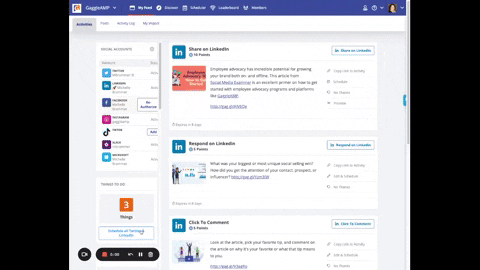
While you can always assign activities to individual employees, GaggleAMP also makes it possible to assign activities to groups (e.g., executives, the sales team, etc.). This makes it easy for you to ensure that each post is relevant to the employees’ networks while still maintaining scalability.
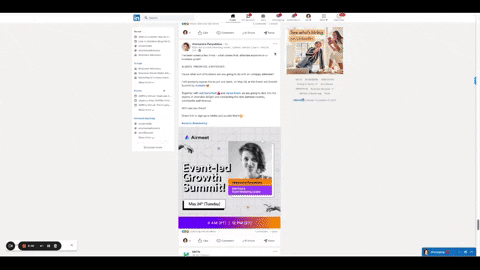
Step 2: Employees Engage With Their Personalized Activities
The success of employee advocacy programs really comes down to one factor; employee participation.
So improving your employee advocacy program's success comes down to removing as much friction for employees as possible.
After doing some analysis, here are just a few common pain points we discovered:
- Employees worry they might say something off-brand
- Employees don't know what content they should share with their networks
- Employees don't have time to log into social media platforms and post content several times per week
- Employees had plenty of other high-value tasks to complete, and engaging regularly takes too much time
To solve these pain points, GaggleAMP provides personalized portals for each employee with specific engagement activities (selected by the manager). This way, employees never have to log onto social media to browse through endless company content and hope they select a relevant piece of content. In fact, the manager can even pre-write text for them, so they don't even have to worry about saying something off-brand.

While choosing a piece of content to engage with or selecting a topic to write about may seem like a simple decision, we’ve found it’s actually a key reason why many employees quit engaging.
In addition, because we realize that most employees don’t have time to post several times per week, GaggleAMP enables employees to schedule their engagement activities to go live later throughout the week.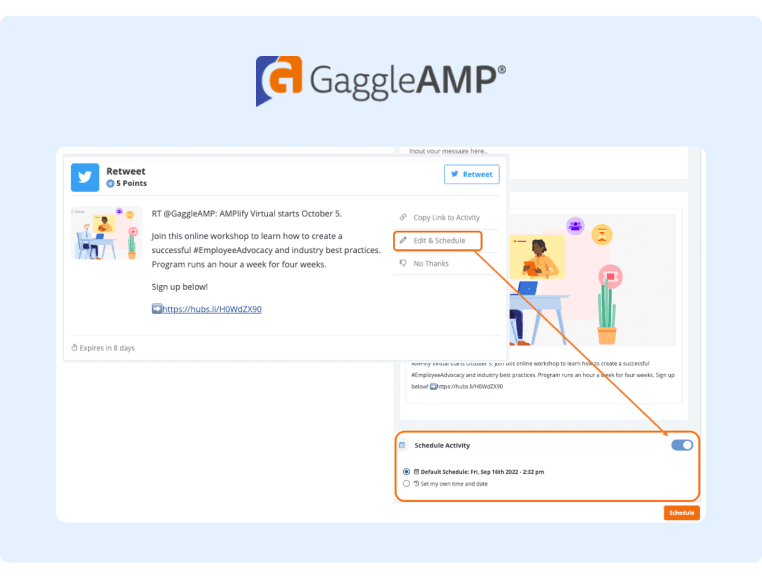
By removing key friction points involved in the engagement process, it only requires a fraction of the employees’ time and effort, which improves engagement rates and the overall success rate of your advocacy program.
Step 3: Measure Results to Optimize Future Campaigns and Reward Employees
Most social media managers ultimately give up on employee advocacy because they can't even effectively measure the results of their efforts. To solve this, GaggleAMP offers a dashboard that enables you to effectively measure metrics like total reach, estimated earned media value, and other KPIs that justify the ROI of employee advocacy.

In addition, GaggleAMP offers a public leaderboard that ranks employees by those with the most engagement points (employees earn points by completing engagement activities). This ignites friendly competition to keep employees engaged, and it gives you an opportunity to reward them for their hard work.

If you’d like to see for yourself if GaggleAMP is a good fit for your social media amplification strategy, schedule a demo today!
Strategy #2: Effectively Leverage Influencer Marketing
One of the best ways to get in front of your target audience is to simply partner with someone who has already spent years building trust with them.
There are plenty of examples of brands built on influencer marketing, though GymShark is a particularly excellent example.
The founders were early adopters of social media influencer marketing, which helped them quickly grow the brand to a $100 million plus company.
However, influencer marketing is much more competitive today, so here are a few simple ways to leverage it in the modern digital marketing landscape.
Target Micro Influencers
Micro influencers with smaller followings are often more closely connected to their audience and therefore have more trust than macro influencers. This means that you're more likely to get a better ROI as the audience is more likely to convert.
There are a few different ways you can find micro influencers.
First, you can survey your audience and ask them who they follow. Chances are that if your existing audience follows an influencer, there's a good chance that the rest of the influencer's audience would be interested in your product as well.
Another option is to use a more traditional influencer platform like Upfluence. Upfluence gives you the opportunity to connect with influencers. Here you can indicate you’re open to collaborations. Then you can handle all of the logistics of the campaign (content creation, analytics tracking, paying the influencer, etc.) directly inside the platform.
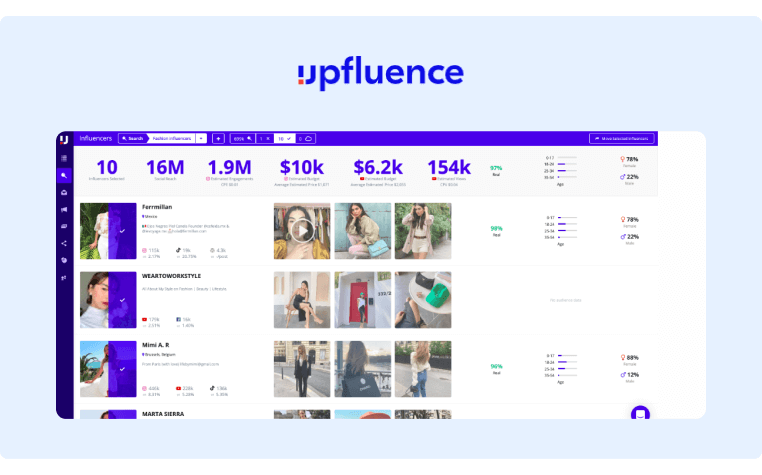
Develop Real Relationships
Another option is to develop relationships with influencers in the space. First, you can look at your list of customers and see if any of your current users are influencers.
If so, you can reach out and propose a collaboration.
However, if you don't currently have any influencers using your product, you can develop relationships with micro influencers by commenting on their posts and promoting their content.
As long as the influencers you try this with aren't too big, they will probably eventually notice your efforts and will be much more likely to take an interest in your business as well.
Here’s a great example of how you can leave a thoughtful comment and engage with the poster:

Once you’ve developed a relationship with them, it’s often pretty easy to do a collaboration and get in front of their audience. However, it’s also important to spend some time building the relationship before you ask for anything.
You can even think of relationships like a bank account – for every interaction you make that helps them, you’re making a deposit and your ask is a withdrawal. So make sure you’ve contributed enough before you ask them to support you.
Strategy #3: Incorporate Social Listening Into Your Daily Routine
Instead of posting content and hoping it gets in front of social media users struggling with the topic discussed, try approaching it the other way around.
Start by finding people discussing a topic where your brand is an expert and then simply answer their questions.
To do that, you can use a social listening tool like Critical Mention, Brandwatch, or Awario, and then enter keywords relevant to your brand. For example, as an employee advocacy platform, we might follow keywords like "employee advocacy," "enterprise social media," or "social media amplification." You can also enter the brand names of your competitors.
Then, these tools will alert you when someone mentions one of those keywords so that you can jump into the conversation and add value.
Here's a great example where a brand that offers something like this could jump in and plug their product:
What is so far the best tool for video #translate? I mean converting an english video to spanish, japanese, etc. with authentic subtitle, voice over, and lip sync if possible. #lipsync #remotework pic.twitter.com/FbXMUz968u
— Cy (@LightField) August 20, 2022
However, some posts are more subtle (or not even necessarily asking for advice). For example, this post discusses the importance of employee advocacy, so it would be worthwhile for someone from our team to jump in and add something insightful to the conversation:

The key to this kind of strategy is to add value rather than blatantly promote your product. For example, rather than talking about why GaggleAMP is a great product, a more interesting comment might be something like:
"100% agree! It's great to see other companies valuing employee advocacy. I think one of the key problems is that most executives don't even know where to start when creating content. What have you done to support your executives with content creation?"
By ending it with a question, it invites the author to respond, and then you can build on the topic.
Strategy #4: Level Up Your Paid Ads
Up until now, all of the strategies we’ve discussed help you build your following across social media channels organically. But, paid ads can still be an effective method to amplify your content’s reach to a wider audience.
While there are entire blogs written about how to run paid ads, here are just a few tips to help you get started.
Execute Competitor Research
One of the best ways to win at paid media is to simply look at your competitors' ads. For example, if you're running Facebook ads, you can just look up your competitors in Meta's ad library. Just type in the industry and a keyword:
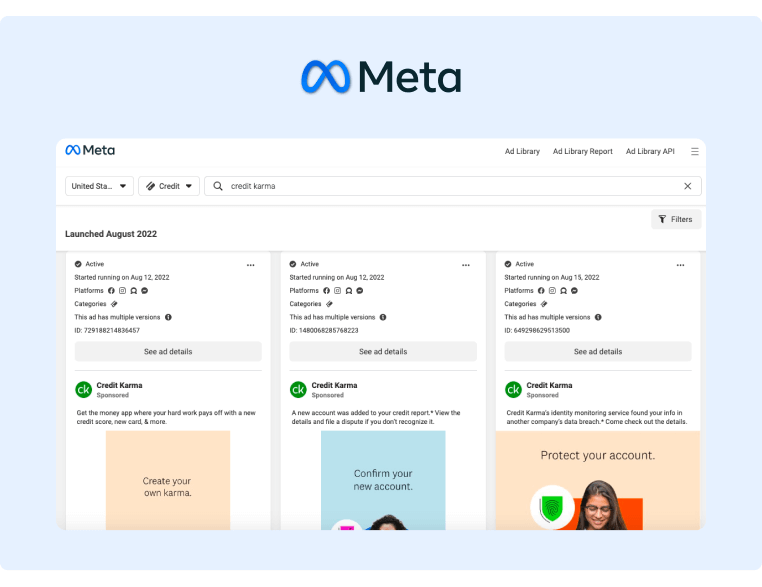
Given that Instagram is owned by Meta, you'll also be able to look up your competitors' Instagram ads in the Meta library.
If you're running LinkedIn ads, you can just go to the brand's page and sort by "Ads."

Unfortunately, Twitter removed its ads transparency center, but you can look at the organic content that resonates with your competitor's audience.
It's worth noting that while those four platforms are the most popular for marketing campaigns, there are others. Platforms like TikTok, Pinterest, and others may be relevant depending on your audience and the type of content they consume.
Capture Customer Information
If your goal is to drive clicks or conversions, capture an email address. Then you can remarket to them for a fraction of the cost and reallocate your precious ad dollars to acquire more first touches.
However, most people aren't willing to give up their email addresses, so you need to offer a valuable lead magnet (ebook, free tool, etc.) in exchange.
The biggest problem I see people make is that the lead magnet they're offering isn't very valuable. So even if you have great copy and a well-optimized landing page, there's a good chance that visitors won't convert into leads if the lead magnet isn't very useful.
So how can you deduce if the problem is the lead magnet quality?
Test it – would your ideal customers be willing to pay money for this?
This is a key reason why many software companies offer freemium versions of their paid product. However, there are also plenty of ebooks and other forms of media that people pay money to access.
If you still need inspiration, look at the lower priced products your competitors sell and make your free lead magnet equally valuable.
Here are a few examples of excellent lead magnets:
- Ahrefs’ free chrome extension
- Hunter.io’s free chrome extension
- ContentMavericks’ Ski Slope Strategy (paid, but you could do this for free)
Continuously Test
Finally, the last step is to continuously test different ads. While running A/B tests isn't particularly challenging, the tricky part is knowing what you should test.
For example, should you test the design of the ad? Is the offer itself not very compelling? Or, if you're running a video ad, is it the hook that's not particularly compelling?
There isn't a single answer to any of these questions, though here are some tips to guide your decisions.
First, talk to your customers.
This is probably the most underrated marketing strategy, as it can help you figure out who to target, how to optimize the copy, and what kinds of graphics/videos resonate.
Another tip is to look at the organic content that has performed particularly well.
For example, if you noticed that rough cell phone videos perform well on your organic social media page, you might decide to create similar style videos for your ads.
Strategy #5: Take an Omnichannel Approach
You probably have a favorite social media channel, and your customers do too. So even if they have an account on LinkedIn, Twitter, and Facebook, they may be spending the majority of their time on just one of those platforms.
Given that most social media posts are short lived, it's unlikely your audience will see your messages if you're only publishing on a platform they check occasionally. That’s why it’s essential to post to multiple social media platforms.
In addition, if they see your brand on multiple social media channels, it helps you double or triple exposure with minimal additional work.
Eric Siu is a great example of a marketer that has successfully used the omnichannel approach to generate millions of visitors.
Here’s an example of how he repurposes the same content across multiple platforms:
You can see the same post on Twitter, but it still gets a great reaction with a new audience:
What people think NFTs are:
— ericosiu.eth 👾 (@ericosiu) August 24, 2022
JPEGs
What NFTs actually are:
- Community
- Physical verification
- Digital identities
- Digital verification
- Digital collectibles
JPEGs are just the tip of the iceberg
The key is to post natively to each platform. So if you post a video to TikTok, you can use the same video on Instagram, but be sure to upload it natively to each platform.
It’s also worth taking some time to understand what each platform prefers. For example, if you’re creating YouTube content, consider creating more shorts as that’s a feature that YouTube is currently pushing.
Final Thoughts
Social media is a great tool to amplify any message, but it’s also important to realize that simply posting to your company’s social media channels will have minimal impact. In fact, the impact usually correlates with your follower count and loyalty.
So if you really want to multiply your brand's message, leverage one of the social media amplification tactics we’ve mentioned.
While we may be biased, we believe that employee advocacy is a particularly strong social media amplification tactic. It’s essentially micro-influencer marketing where the influencers are wholly invested in your company (and as an added bonus, you don’t have to pay an influencer fee).
If you want a simple tool that makes it easy to run a successful employee advocacy program, schedule a demo of GaggleAMP today!










